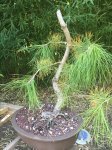Please! No more cutting!
The tree is very weak. Let it grow for now, and fertilize. Use fish emulsion every week from now until the first of December. This will help it develop buds for next spring.
That top section above the bar branches is dead. You always have to leave some needles (foliage) on a branch (trunk). They're what pulls food up the sap line. So, you CAN cut that section off.
One of those two remaining branches up top can (should) be wired up to become the new leader. If you want a tall tree eventually.
The internodes on this tree are far apart. Internodes, if you don't know, are the distances between branches. Pines usually only produce branches at internodes. So, you're not likely to get any more branches on this tree without grafting.
It's possible to get dormant needle buds to pop, but it's rare. And the tree has to be really strong for that to happen.
So fertilize well, next spring up pot into a slightly larger, deeper pot to build strength. And bury those surface roots a bit.
 Hello! So, this is my first JBP and from what I've read I may have waited too long to cut the branches(I live in Dallas). When would it be okay to prune back? Should I wait till the winter? Or should I let it grow to thicken the branches? Obviously the branches have done quite a bit of growing over the summer. I think I understand the principles of cutting the weaker branches first to allocate energy. Any advice/suggestions are appreciated. Thanks!
Hello! So, this is my first JBP and from what I've read I may have waited too long to cut the branches(I live in Dallas). When would it be okay to prune back? Should I wait till the winter? Or should I let it grow to thicken the branches? Obviously the branches have done quite a bit of growing over the summer. I think I understand the principles of cutting the weaker branches first to allocate energy. Any advice/suggestions are appreciated. Thanks!

